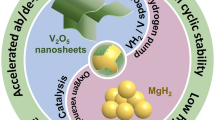Abstract
In CO hydrogenation over Rh/SiO2 catalysts, the effect of additive metal oxides on C-O bond dissociation was studied by using pulse surface reaction rate analysis (PSRA). The addition of oxides of Al, Ti, Cr, V, and Mn resulted in an increase in the rate constant for the dissociation according to this sequence, while the oxides of Cu, Zn, and Ag added decreased the rate constant to almost the same extent. In contrast to these metal oxides, MoO3 and WO3 did not change the dissociation activity. CO adsorption measurement indicated that all of the added metal oxides covered a considerable portion of the Rh metal surface, although the efficiency of covering was different from one metal oxide to another. Covering the Rh metal surface with an added metal oxide should decrease the rate constant of C-O bond dissociation, because ensemble sites, consisting of a group of surface Rh atoms and considered necessary for the dissociation, were destroyed. The suppression effect resulted from the destruction of the ensemble sites by adding the oxides of Cu, Zn, and Ag. For other metal oxides, temperature-programmed reduction (TPR) or O2 uptake measurement revealed that the added oxides, especially those existing on the Rh metal surface, were in a partially reduced state under reaction conditions. Owing to its high affinity for an oxygen atom, the cation in a partially reduced state participated in the reaction in such a way that the oxygen end of adsorbed CO species was bound to the cation so as to dissociate the C-O bond, which resulted in promotion of the dissociation. The observed promotion was explained in terms of the enhancement owing to the high affinity sufficient to overcome the suppression caused by destroying ensemble sites. Lack of the promotion effect of MoO3 and WO3 might result from a balance between promotion due to the high affinity of the partially reduced Mo or W and suppression caused by destroying ensemble sites. Excellent correlation was observed between the intrinsic activity increase, from which the suppression effect was excluded, and the heat of formation of metal oxide including MoO3 and WO3. Since the heat of formation of metal oxide is considered to be a measure of the affinity, this correlation supports the idea that the high affinity of additive cations for an oxygen atom is of primary importance in the promotion of C-O bond dissociation in CO hydrogenation.
Similar content being viewed by others
References
A. T. Beli, Catal. Rev., 23, 203 (1981).
P. Biloen and W.M.H. Sachtler, Adv. Catal., 30, 165 (1981).
M.M. Bhasin, W.J. Bertley, P.C. Ellgen, and T.P. Wilson, J. Catal., 54, 120 (1978).
T.P. Wilson, P.H. Kasai, and P.C. Ellgen, J. Catal., 69, 193 (1981).
M. Ichikawa, T. Fukushima, and K. Shikakura, Proc. 8th Int. Congr. Catal., 2, 69 (1984).
H. Arakawa, T. Hanaoka, K. Takeuchi, T. Matsuzaki, and Y. Sugi, Proc. 9th Int. Congr. Catal., 2, 602 (1988).
T. Mori, H. Masuda, H. Imai, A. Miyamoto, S. Baba, and Y. Murakami, J. Phys. Chem., 86, 2753 (1982).
T. Mori, A. Miyamoto, H. Niizuma, N. Takahashi, T. Hattori, and Y. Murakami, J. Phys. Chem., 90, 109 (1986).
T. Mori, A. Miyamoto, N. Takahashi, M. Fukagaya, T. Hattori, and Y. Murakami, J. Phys. Chem., 90, 5197 (1986).
N. Takahashi, T. Mori, A. Miyamoto, T. Hattori, and Y. Murakami, Appl. Catal., 22, 137 (1986).
N. Takahashi, T. Mori, A. Miyamoto, T. Hattori, and Y. Murakami, Appl. Catal., 38, 61 (1988).
N. Takahashi, T. Mori, A. Miyamoto, T. Hattori, and Y. Murakami, Appl. Catal., 38, 301 (1988).
M. Ichikawa, A.J. Lang, D.F. Shriver, and W.M.H. Sachtler, J. Am. Chem. Soc., 107, 7216 (1985).
T. Hattori, H. Matsumoto, and Y. Murakami. In: Preparation of Catalysts IV B. Delmon, P. Grange, P.A. Jacobs, and G. Poncelet, (Eds.), p. 815, Elsevier, Amsterdam (1987).
J. Blyholder, J. Phys. Chem., 68, 2772 (1964).
A.C. Yang and C.W. Garland, J. Phys. Chem., 61, 1504 (1957).
J.R. Anderson. In: Structure of Metallic Catalysts, p. 296, Academic Press, London (1975).
T. Mori, H. Masuda, H. Imai, A. Miyamoto, H. Niizuma, T. Hattori, and Y. Murakami, J. Mol. Catal., 25 263 (1984).
T. Mori, A. Miyamoto, N. Takahashi, H. Niizuma, T. Hattori, and Y. Murakami, J. Catal., 102, 199 (1986).
S. Taniguchi, Y. Mori, T. Hattori, Y. Murakami, and T. Mori, J. Chem. Soc., Faraday Trans. 1, 85, 3135 (1989).
Author information
Authors and Affiliations
Rights and permissions
About this article
Cite this article
Kato, H., Nakashima, M., Mori, Y. et al. Promotion effect of metal oxides on C-O bond dissociation in CO hydrogenation over Rh/SiO2 Catalyst — possible role of partially reduced state cations. Res. Chem. Intermed. 21, 115–126 (1995). https://doi.org/10.1163/156856795X00116
Received:
Accepted:
Issue Date:
DOI: https://doi.org/10.1163/156856795X00116




